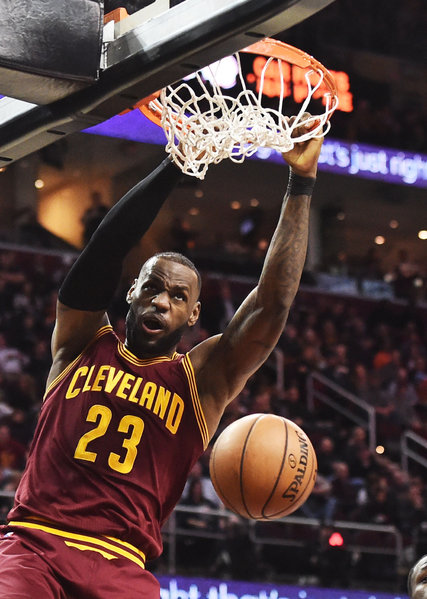LeBron James and the Cleveland Cavaliers played at Madison Square Garden on Saturday night, fulfilling their manifest destiny as basketball villains and bullies against the Knicks. But as this N.B.A. regular season barrels toward the playoffs, perhaps the locals should be more supportive. The Cavaliers, after all, still represent the Eastern Conference’s best and last line of defense against the stubbornly superior, haughty West.
In the N.B.A., yet again, West is best. That is a fact of life over the past decade, much more than a fleeting phase or cycle. Going into the weekend, the 15 Western Conference teams cumulatively stood 27 games over .500 — well on their way to recording an aggregate edge over the East for a ninth straight season dating to 2008-9. During that span, the East has managed to win the championship only three times, all on the gifted back of James in either Miami or Cleveland.
“It just shows just how good James is,” said Jeff Van Gundy, the former coach and current ESPN analyst. “There’s always a lot of stuff surrounding him, but you can’t take your eyes off him on the court.
“If you just focus on the way he plays, 14 years in, he’s a dominant, dominant player.”
That is no longer a mystery. What is a little harder to grasp is how the Western Conference has managed to retain its significant advantage over such a long time. The West’s best teams always seem a little better. The East’s worst teams often appear a bit worse. The Boston Celtics and the Washington Wizards are evolving, coming on strong, yet the Golden State Warriors and the San Antonio Spurs still own the best records in the league by a considerable margin.

The Warriors, in particular, remain an intimidating bunch, the gold standard.
“Right now, the Warriors have such a dominant talent advantage, it is going to be virtually impossible for them to be caught,” Van Gundy said. “This differential between best and next best, the gap is so large, you don’t see it in any other sport. To beat them, if they’re healthy in a series, is going to be very hard.”
In addition to Golden State, the Spurs have been a rock-steady power for more than a decade in the West, while teams such as the Los Angeles Clippers and the Houston Rockets provide substantial competition. Consistency is a hallmark of the conference, unmatched in the East.
An executive from one of the elite teams, who requested anonymity because he was discussing the merits of other clubs, said there were perhaps “seven or eight” reasons for the West’s superiority. He noted that ownership had been more stable in the West, and that superstars generally had wanted to sign with teams in warmer climates and with generally lower state income taxes.
The biggest defections have been East to West, not the other way, dating to Shaquille O’Neal’s move from Orlando to Los Angeles, and Kobe Bryant’s refusal before draft day to play for the New Jersey Nets. More recently, Kevin Durant flirted with the Boston Celtics, then ended up with Golden State.
Not by coincidence, other than James, all those voted to the All-N.B.A. team the past two seasons were from the West. And the West has won five of the past six All-Star Games.
Esteemed coaches like the Spurs’ Gregg Popovich also make a difference in the West-East gap. So can specific failings of individual franchises. In New York, for example, the Knicks were plagued for years by volatility at the management level while the Nets have been steered, in large part, by an absentee Russian owner. Other teams were tightfisted.
“There are places where it’s changing now,’’ the team executive said. “ Atlanta is much better. Milwaukee has become a team of the future with new venture capital.”
Playing styles vary between conferences, though several Eastern teams can now run and gun with anyone. “You’re not going to beat the West by grounding and pounding,” the executive said. “Cleveland was built to be a blitzkrieg offense, and LeBron has been on teams that were able to play that type of game. He makes it easier.”
The Cavaliers are title threats again this season, having split two regular-season games with the Warriors, after stunning them in seven games in last year’s N.B.A. finals. Going into the weekend, Golden State led the league in offense with 118.4 points per game, while the Cavaliers were fourth, behind Houston and the Denver Nuggets, at 110. The Warriors were second behind San Antonio in 3-point shooting percentage, while Cleveland was third. The Warriors owned a substantial edge over everyone in assists and steals, further testimony to their whirlwind pace.
Most eyes, again, will be on the Western Conference playoffs, simply because there are so many strong teams involved. One sign, though, that the West may be nearing its fall-of-the-Roman-Empire moment: For the first time since 1997, the final playoff qualifier in the Western Conference may well post a sub-.500 record, a far more typical occurrence in the East.
That won’t be enough to sabotage the Warriors, but it suggests that greater parity may be lurking somewhere around the turn of the decade.
Source: New York Tim
